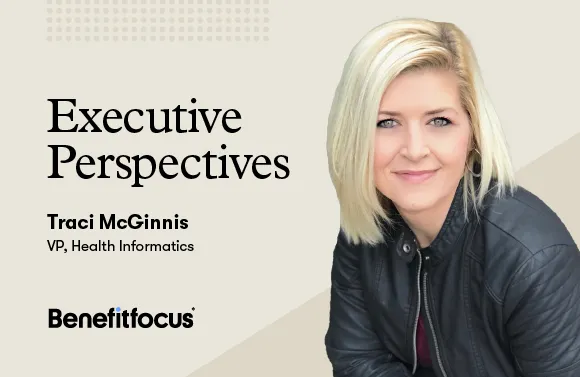
In this edition of Executive Perspectives, Traci McGinnis, Vice President of Health Informatics, shares her thoughts on benefits industry trends, what keeps benefit leaders up at night, how data is transforming the employee experience and the future of workplace benefits.
Q: Considering the macro trends impacting employers, benefits advisors and health plans, where do you think the industry is heading in the next five years?
A: There’s movement in the industry thanks to legislation like the Consolidated Appropriations Act and Transparency in Coverage regulations to help employers effectively manage their plan assets as fiduciaries. I hope that in the next five years, we’ll see tremendous change in driving down costs while improving access to quality health care through federal transparency requirements that put control back in the hands of plan sponsors.
We’re starting to see employers recognizing that to effectively manage their plans, they must review plan data regularly. With access to accurate and comprehensive data, employers are empowered to manage costs while responsibly and effectively improving their employees' health.
Decision support is a great example of this. Increasingly, employers and consumers have access to tools that help them be educated health care shoppers. Most of us wouldn’t walk into a store and blindly purchase an item, then wait 30 days to find out what it costs. Today, employers can drive employees toward better decisions backed by data. This starts with benefit selection but includes everything from offering digital health solutions that target the member population’s needs, optimizing plan design and providing oversight of the accuracy of claim payments.
Q: What issues keep benefit leaders up at night?
A: How do I ensure my employees are cared for financially, physically and mentally?
Over the past decade, health benefit costs have tended to increase faster than the rate of inflation and wage growth. This has made it incredibly tough for benefit leaders to develop competitive total compensation packages for employees and design benefit packages that optimize costs… all while keeping more dollars in employees’ pockets and ensuring they have access to high-quality health care.
In 2022, one in four U.S. adults reported delaying or avoiding care due to cost. This has a direct impact on productivity and absences for employers. Despite 90% of American adults reporting they have health insurance — and 85% reporting good health — almost half of American adults (45%) are worried about their ability to pay medical bills. There are clear disparities when you analyze this data based on age groups, poverty level, geographic location, and race and ethnicity.
Other new trends also impact employer costs. The introduction of GLP1s for weight loss, for example, has created debates among health plans and plan sponsors over the coverage of these drugs. More Americans want access to these drugs, and spending will continue to increase while employers decide whether and how to cover them.
Similarly, cell and gene therapies can potentially improve health outcomes and may affect total health spending. This may prove a net positive if it significantly impacts employee health — but employers will have to balance the cost of these new therapies against unknown future savings resulting from the improved health of plan members.
Q: Where are the biggest opportunities with health care analytics?
A: Honestly, the opportunities with health care analytics are huge and multi-faceted.
In health systems, analytics combined with artificial intelligence and machine learning technologies will drive personalized medicine and treatment plans, operational optimization in hospitals and other care sites, and enhanced clinical decision support systems.
The speed at which these technologies are coming to market is incredible, and I’m encouraged by how data is being used to refine and evolve health care. As a technology vendor in benefits administration and claim analytics, we integrate data to provide clients with new and exciting ways to enhance their benefit offerings and provide deeper value to employees.
The most obvious use of claims data is informing decision support tools that help employees select the right benefits for their needs. But the opportunity is much larger than that. Health care analytics can drive hyper-personalized member experiences by using data to help employees select benefits based on their personal claim history and also to help them take full advantage of their benefits when they need them most. We’re focused on using data to ensure people get the care they need, when they need it, at the right place, for the best price.
For employers, there’s a huge opportunity to understand the health of their employee populations, using analytics to review risk and predict costs, identify cost-saving opportunities and optimize plan design. By leveraging health care data and technology, employers can finally shift from a reactive approach to benefits management to a proactive approach.
Using price transparency data combined with care navigation, health advocacy, digital health solutions and optimized plans — all overlayed with insights on the effectiveness of these strategies — will help employers make the right decisions at the right time to offer their employees quality care while minimizing costs for themselves and their members.
Q: How can benefits leaders use health care analytics to help reduce health care costs?
A: So many ways! Successful strategies we’ve seen include using analytics to:
- Manage utilization costs, prescription costs and chronic condition compliance
- Minimize fraud, waste and abuse
- Optimize plan design
When you have access to the data, you can model savings by “re-adjudicating” claims under different conditions and then implement strategies to effect positive change. For example, non-emergent or avoidable emergency room spend can be a huge cost to a plan. Looking at the claims data to understand what you are spending on non-emergent ER visits — and WHY members might be seeking care in the ER — helps benefit leaders adjust plans accordingly while educating members.
We had a client who identified that a proportion of their ER care was non-emergent. After analyzing the data, they determined this was driven by second and third-shift employees seeking care outside normal office hours. By implementing telemedicine benefits and educating members, this employer cut costs, saving significantly over two years. For a mid-sized employer, these were meaningful savings.
Medication compliance for chronic conditions is another opportunity for savings. Having access to claim data and the right tools helps benefit leaders identify gaps in care and understand WHY employees and members may not be taking the medications they need to stay healthy.
For example, diabetics who don't take their medication may ultimately incur more costs than those who maintain their treatment plans. We had a client who used their data to implement formulary changes to make needed medications more affordable to employees and saw a significant increase in diabetic medication compliance in one year. This not only reduced the overall cost to the plan but also increased employee productivity through a healthier population.
Q: How can claim data improve transparency, and what impact does that have for employers?
A: This is perhaps the area where I am most passionate. I have been continuously amazed at the waste and abuse, and unfortunately, occasional fraud that data uncovers.
Our clients have used their data to identify fraud, waste and abuse in their claims. Real-world examples include uncovering duplicate payments, inflated severity levels in ER billing, and outrageous prices — for example, billing at 10,000% of Medicare rates.
When your health plan or TPA provides full data transparency you can you better exercise your fiduciary responsibility as a plan sponsor. I’m encouraged by recent legislation that aims to ensure plan sponsors can obtain detailed claim data to ensure claims are billed and paid appropriately. While the legislation isn’t perfect, many in our industry are passionate about this topic and continue to advocate for data rights and transparency.
It’s through these efforts that plans will finally be able to effectively manage their assets, and health care consumers will be able to make better and more affordable care decisions.
Q: How can employers best demonstrate the value of their benefits package to employees – and health plans to members?
A: The value happens when you can make it personalized. Today, we’re constantly surrounded by personalization, and people have come to expect it. When I log into a streaming service, I’m presented with all the shows and movies I might like based on my watch history. When I log into online retailers, I’m presented with all the products I may be interested in based on my purchase history. I don’t want to be shown things that aren’t relevant to me. And, increasingly, I’m not.
Health care needs to catch up. The next step is to bring value to benefits through personalization. Decision support tools connected to wages, savings and claim history can offer employees personalized guidance that meet their needs.
When I joined the workforce a couple of decades ago, our benefits were relatively basic — maybe two medical plans, dental and vision. Now, employers offer a smorgasbord of benefits and need to ensure the right offerings reach the right people — and, more importantly, that employees understand and use those benefits.
Combining data and the right tools can make a huge difference. The single best way to demonstrate value is to provide employees with personalized guidance during OE and significant life events that will improve their health and financial outcomes.
Q: What does the future of workplace benefits look like?
A: The future of workplace benefits will be defined by increasingly personalized member experiences. Fundamentally, everyone in the ecosystem benefits from members becoming the most informed and diligent consumers of healthcare — and most people are fully capable of that, so long as they have personalized guidance and support on hand when they need it most.
So what does that look like? At a simplistic level, it means choosing the right benefits and extracting the maximum possible financial and health value from them.
At a more granular level, it looks like the intelligent and automated use of program and claims data to give employees/members clear, personalized prompts at exactly the moments they need them. For example:
- Suggesting new benefits and solutions to sufferers of specific chronic conditions
- Making it easy to find the most appropriate health care providers for an immediate need
- Providing smart suggestions that are likely to be useful instead of promoting all new benefits and solutions to the entire employee population
And then, from an employer’s perspective, the same data can be used to:
- Ensure benefit offerings are tailored to the employee population
- Identify fraudulent or wasteful spending
- Track the cause-and-effect chain for benefits initiatives, from identifying issues and determining solutions all the way to tracking the effectiveness and ROI of those solutions.
For all of this to be possible, we need to move away from the idea of a “benefits administration platform” and towards technology that intelligently leverages program and claims data to improve every stage of the employee journey.
The information provided does not, and is not intended to, constitute legal advice; instead, all information and content herein is provided for general informational purposes only and may not constitute the most up-to-date legal or other information. Benefitfocus does not act in a fiduciary capacity in providing products or services; any such fiduciary capacity is explicitly disclaimed.


